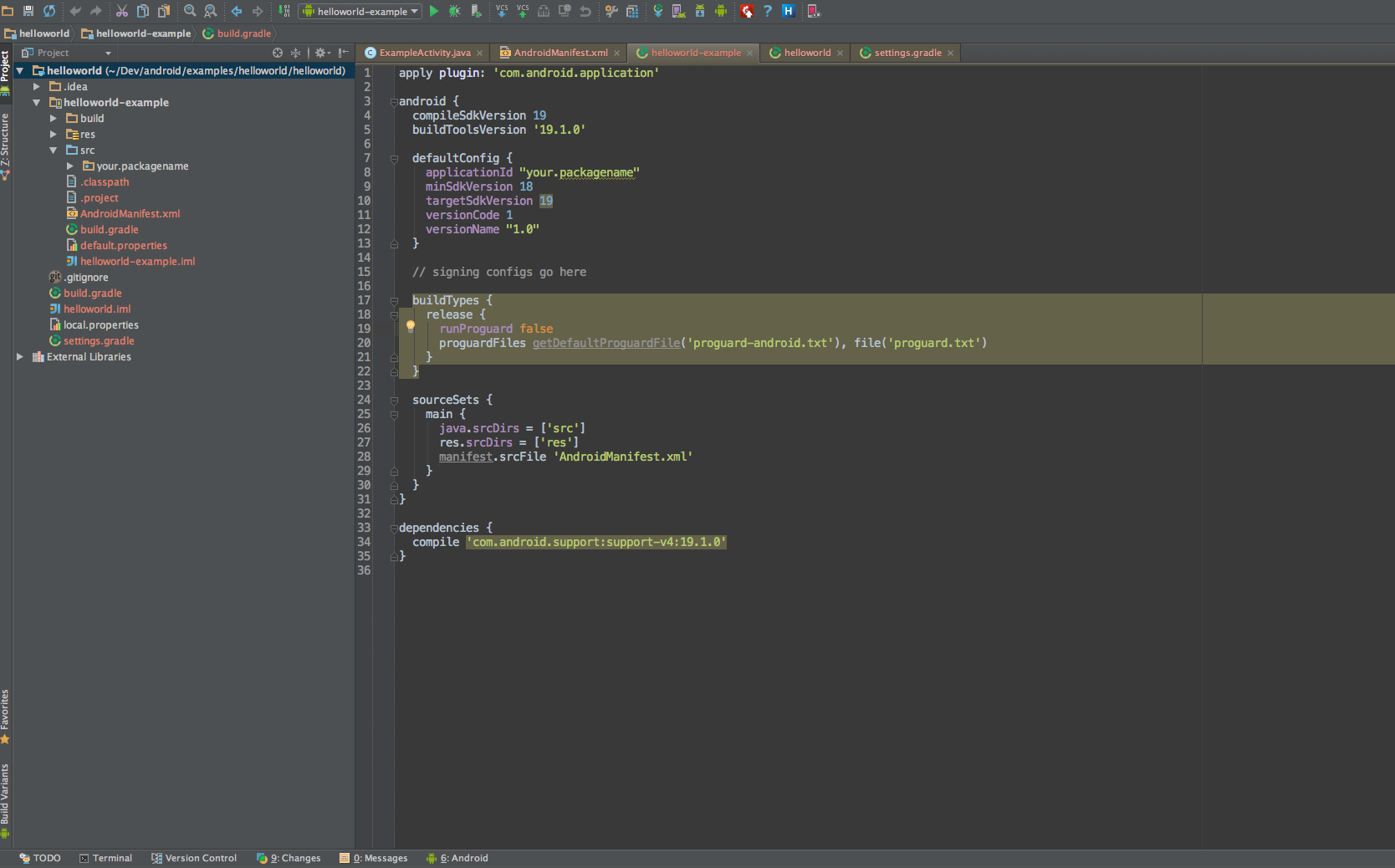Switching from RoboGuice to Dagger 2

Recently, we decided that we wanted to let go of a deprecated, unmaintained RoboGuice and move to Dagger 2. There were two main reasons for this:
- Better performance, since Dagger doesn’t use runtime reflection,
- Method count, since RoboGuice adds about 10,000 methods
Import ButterKnife and Dagger 2
First things first, I removed RoboGuice from build.gradle and added ButterKnife and Dagger 2.12
build.gradle
implementation "com.google.dagger:dagger:2.12" annotationProcessor "com.google.dagger:dagger-compiler:2.12" implementation "com.jakewharton:butterknife:8.8.1" annotationProcessor "com.jakewharton:butterknife-compiler:8.8.1"
@InjectView
We used RoboGuice’s InjectView a lot, so we had to do something about that, we decided to go with ButterKnife. It was pretty simple. Three steps:
- Use “Replace in Path” to replace all instances of
@InjectViewwith@BindView - A simple regexp to remove
privatefrom all those fields since ButterKnife doesn’t allow private fields - Replace
import roboguice.inject.InjectView;withimport butterknife.BindView; - In every Activity and Fragment, call
ButterKnife.bind(this)(inonCreate) orButterKnife.bind(this, view)(inonCreateView) - Remove all RoboGuice injector calls in those classes.
Google annotations to javax annotations
Again, simple stuff, just a matter of replacing the imports. Replace in Path, find import com.google.inject. and replace with import javax.inject.
The grunt work
Now lets build our object graph. With RoboGuice, we had an AppModule.java file that extended AbstractModule and overrode its configure() method. In it, we bound each interface with it’s implementation depending on the flags set in the app. This isn’t how Dagger does it so I made two new files:
- AppModule
- AppComponent
In the AppModule, I first wrote a constructor that took Context, so that I can provide that to all classes that depend on it.
AppModule.java
@Module public class AppModule { private Context appContext; public AppModule(Context context) { this.appContext = context.getApplicationContext(); } @Provides Context context() { return appContext; }
Here’s how we provide an instance of a hypothetical ApiService implementation, which depends on a PreferenceHelper class.
AppModule.java
@Provides ApiService apiService(ApiServiceImpl impl) { return impl; }
Turns out that this is the right way to use Dagger to provide an implementation. Where’s the constructor call? In the generated code! Here’s the class definition for ApiService.
ApiService.java
public abstract class ApiService { public ApiService(PreferenceHelper preferenceHelper) { this.preferenceHelper = preferenceHelper; } }
There’s no @Inject on this constructor since this is an abstract class. This is ApiServiceImpl. This is where the magic happens.
ApiServiceImpl.java
@Singleton public class ApiServiceImpl extends ApiService { @Inject public ApiServiceImpl(PreferenceHelper preferenceHelper) { super(preferenceHelper); } }
To provide an instance of PreferenceHelper, Dagger figures out where to get it and then calls the constructor. Here’s the generated factory class:
ApiServiceImpl_Factory.java
public final class ApiServiceImpl_Factory implements Factory<ApiServiceImpl> { private final Provider<PreferenceHelper> preferenceHelperProvider; public ApiServiceImpl_Factory(Provider<PreferenceHelper> preferenceHelperProvider) { this.preferenceHelperProvider = preferenceHelperProvider; } @Override public ApiServiceImpl get() { return new ApiServiceImpl(preferenceHelperProvider.get()); } public static Factory<ApiServiceImpl> create( Provider<PreferenceHelper> preferenceHelperProvider) { return new ApiServiceImpl_Factory(preferenceHelperProvider); } }
And PreferenceHelper is just a simple class with a @Singleton annotation up top and an empty constructor with @Inject annotation so Dagger knows this is a dependency to provide and its scope is Singleton.
Now, most of our provided classes used field injection instead of constructor injection, which doesn’t play as nicely with Dagger so I had to write those new constructors and field assignments by hand but aside from that, didn’t have to worry about where those dependencies came from. Eventually, my AppModule.class looked a lot like this:
AppModule.java
@Module public class AppModule { private Context appContext; public AppModule(Context context) { this.appContext = context.getApplicationContext(); } @Provides Context context() { return appContext; } @Provides ApiService apiService(ApiServiceImpl impl) { return impl; } @Provides Service1 service1(Service1Impl impl) { return impl; } @Provides Service2 service2(Service2Impl impl) { return impl; } // A few other services ... }
Now that’s done. Dependencies that didn’t have to extend an abstract class or interface simply used @Inject in their constructor and Dagger provided them. On to AppComponent.java
AppComponent.java
@Singleton @Component(modules = {AppModule.class}) public interface AppComponent { void inject(MyApp app); void inject(MainActivity activity); // Other activities, fragments, Broadcast Receivers, and Android Services }
We have some @Inject calls in our Application class (probably should clean that up now) so we call inject(this) in it, and also all activities, fragments, and Android services. Basically, wherever we can’t use constructor injection.
Almost there
Time to build the app so Dagger can generate all the code using its annotation processor. And finally, use that code in the custom Application class.
MyApp.java
public class MyApp extends Application { private static MyApp application; @Inject SomeDependency dependency; @Override public void onCreate() { super.onCreate(); getAppComponent().inject(this); } public static NortonApplication getApplication>() { return application; } public void createAppComponent() { appComponent = DaggerAppComponent.builder().appModule(new AppModule(this)).build(); } public static AppComponent getAppComponent() { MyApp app = getApplication(); if (app.appComponent == null) { app.createAppComponent(); } return app.appComponent; }
With this, at least the application class should be able to get its fields injected, but our Activities, Fragments, Broadcast Receivers, and Services still won’t. For that, we need to call inject(this) in those too. That’s why we have that static getAppComponent() method. So we simply call this in the onCreate method of all those classes (yes, fragments too because we might need to use those fields in onStart).
MyApp.getAppComponent().inject(this);
Optimizations
So this works, but it creates a lot of factory classes for us. Turns out, class loading is pretty slow on Android and the system needs to do that every time the app has been destroyed and launched again. That means cold launch time, while slightly better than RoboGuice can still be improved. That, I will cover in the next part. Until then, you can watch this video about Dagger 2.12 optimizations.
